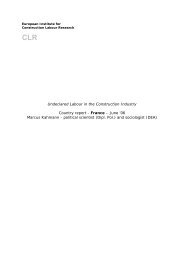Japan – what can we learn? - Construction Labour Research
Japan – what can we learn? - Construction Labour Research
Japan – what can we learn? - Construction Labour Research
Create successful ePaper yourself
Turn your PDF publications into a flip-book with our unique Google optimized e-Paper software.
of architectural design, engineering, research and development as <strong>we</strong>llas a main construction division. On the other hand, more than half ofthe firms hold less than 10 million yen as capital, and 23.7% is run byone person. Table 1 shows that the largest firms (only 0.3% of thetotal number) receive 45.4% of the order with an average order byfirm that is hundred times the total average.Table 1: Number of construction firms and amount of order by firm scale, 2004capital scale (yen*) offirmnumber offirmsrateamount oforderrateaverageamount oforder perfirmOver 10 billion 1,632 0.3 24,731,691 45.4 15,154.21-10 billion 4,796 0.9 6,472,612 11.9 1,349.650 million <strong>–</strong> 1 billion 10,697 1.9 5,808,912 10.7 543.010-50 million 216,248 38.7 16,149,699 29.6 74.7Under 10 million 192,809 34.5 1,250,602 2.3 6.5Person 132,675 23.7 60,960 0.1 0.5Total 558,857 100.0 54,474,275 100.0 97.5Data source: Ministry of Land, Infrastructure and Transport, Policy Bureau* 1 yen = 114 US dollar, 144 €• Employment practice in a peripheral labour marketIn labour research studies, researchers often note that constructionprojects inevitably entail subcontracting systems because of thevulnerability to seasonable and market demand or the specific needsfor individual skills and workforce in a particular project. In <strong>Japan</strong>, inaddition to these industrial traits in the production system, theconstruction labour market as a whole is destined to be a secondarylabour market for absorbing redundant workforces from otherindustries, which means most workers have historically been recruitednot from new graduates or younger apprentices, but from domesticmigrants from rural areas or from the unemployed. On the one hand,public investment guarantees relatively stable market demand; one theother, there have been few regulations established for protectingworking conditions or rights in subcontracting employment practices.This is quite a contrast to <strong>Japan</strong>ese conventional employment practiceof internal and lifelong employment in the primary labour market.Therefore, construction work is more or less stigmatised as a lo<strong>we</strong>rstatus job. This also reflects recent problems: the crisis of aging ofCLR News No 2/200632









